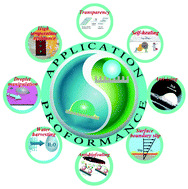A comparison between superhydrophobic surfaces (SHS) and slippery liquid-infused porous surfaces (SLIPS) in application
Abstract
Slippery liquid-infused porous surfaces inspired by the Nepenthes pitcher plant exhibit excellent performances and are known for their extremely low contact angle hysteresis (<5°) and smooth surface. In contrast, superhydrophobic surfaces (SHS) exhibit poor pressure stability, difficulty in self-healing, and difficulty in removing low surface tension liquids or organic solvents, which can affect the stable air layer. Thus, these issues can be avoided through the replacement of SHS with slippery liquid infused porous surfaces (SLIPS). In this review, the theoretical models of SHS and SLIPS are classified initially, and several design standards for the preparation of SLIPS are briefly described. Then, we focus on comparing the differences in the application of SHS and SLIPS, such as pressure stability, transparency, and droplet manipulation. However, there are still some problems that need to be improved during the preparation of SLIPS, such as the evaporation of the lubricant layer, the use of a lubricant layer of toxic perfluoropolyether and other substances, and easily lost nanostructured lubricant layer. Accordingly, several new improved methods are proposed in this review, and finally, the potential applications and development prospects of SLIPS are presented.

- This article is part of the themed collection: Recent Review Articles


 Please wait while we load your content...
Please wait while we load your content...